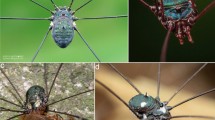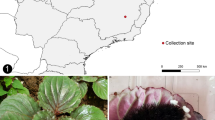Abstract
The reproductive system and sperm morphology provide informative (but not so usual) characters in the systematic analysis, also it is still scarce for most of the insect taxa. Miridae is the largest family of Heteroptera, moreover, lower systematic relationships are still contentious, especially for the Bryocorinae subfamily. Due to the lack of data concerning Eccritotarsini (Bryocorinae), we described the male reproductive system and sperm morphometry of three species, including Bothrophorella nigra, Sixeonotus brasiliensis, and Pycnoderes incurvus. Our results showed that a single follicle per testis could be the typical follicular number for Eccritotarsini. To Miridae, the pair of medial accessory glands is often shorter than the lateral ones, as indicated by the gland morphology in Bryocorinae and Mirinae. A single pair of glands in B. nigra suggests it to be an autapomorphy in this taxon. We notice that a subdivided seminal vesicle is described only for Mirinae and no other heteropteran so far. There is a continuous sperm production in P. incurvus in the adult by the presence of cysts at distinct developmental stages. Also, sperm morphometry was unique for each species, and the total length in B. nigra (282 µm) was nearly twice that found for P. incurvus (174 µm) and S. brasiliensis (135 µm).



Similar content being viewed by others
Availability of data and materials
Not applicable.
Code availability
Not applicable.
References
Akingbohungbe AE (1983) Variation in testis follicle number in the Miridae (Hemiptera: Heteroptera) and its relationship to the higher classification of the family. Ann Entomol Soc Am 76:37–43. https://doi.org/10.1093/aesa/76.1.37
Barcellos MS (2018) Morfologia dos espermatozoides Hemiptera Dalbulus maidis (DeLong e Wolcott, 1923) (Cicadelidae), Collaria oleosa (Distant, 1883) e Prepops zetterstedti (Stål, 1860). Thesis, Universidade Federal de Viçosa
Barcellos MS, Martins LCB, Cossolin JFS et al (2015) Testes and spermatozoa as characters for distinguishing two ant species of the genus Neoponera (Hymenoptera: Formicidae). Fla Entomol 98:1254–1256. https://doi.org/10.1653/024.098.0441
Candan S, Özyurt Koçakoğlu N, Suludere Z (2018) Morphological and histological structure of the male reproductive system of the water strider Gerris lacustris (Linnaeus 1758) (Gerridae, Heteroptera). Microsc Res Tech 81:770–780. https://doi.org/10.1002/jemt.23035
Cassis G, Schuh RT (2012) Systematics, biodiversity, biogeography, and host associations of the Miridae (Insecta: Hemiptera: Heteroptera: Cimicomorpha). Annu Rev Entomol 57:377–404. https://doi.org/10.1146/annurev-ento-121510-133533
Cursino MS, Duarte JMB (2016) Using sperm morphometry and multivariate analysis to differentiate species of gray Mazama. R Soc Open Sci 3:160345. https://doi.org/10.1098/rsos.160345
Dallai R, Afzelius BA (1980) Characteristics of the sperm structure in Heteroptera (Hemiptera, Insecta). J Morphol 164:301–309. https://doi.org/10.1002/jmor.1051640306
Ferreira PSF, Henry TJ, Coelho LA (2015) Plant bugs (Miridae). In: Panizzi AR, Grazia J (eds) True bugs (Heteroptera) of the neotropics. Entomology in focus. Springer, Dordrecht, pp 237–286
Freitas S, Santos-Mallet J, Costa J et al (2008) A comparative study of testis follicles in species of Triatoma (Hemiptera, Triatominae). Anim Biol 58:227–233. https://doi.org/10.1163/157075608X328062
Gomes MO, Castanhole MMU, de Souza HV et al (2013) Morphological aspects of the testes of 18 species of terrestrial of Heteroptera from Northwestern São Paulo (Brazil). Biota Neotrop 13:131–135. https://doi.org/10.1590/S1676-06032013000300016
Gottardo M, Dallai R, Mercati D et al (2016) The evolution of insect sperm − an unusual character system in a megadiverse group. J Zool Syst Evol Res 54:237–256. https://doi.org/10.1111/jzs.12136
Horton DR, Lewis TM (2011) Variation in male and female genitalia among ten species of North American Anthocoris (Hemiptera: Heteroptera: Anthocoridae). Ann Entomol Soc Am 104:1260–1278. https://doi.org/10.1603/AN11087
Jamieson BGM, Dallai R, Afzelius BA (1999) Insects: their spermatozoa and phylogeny. Science Publishers, Inc, Enfield
Javahery M (2019) Natural history of Corythucha juglandis and Gargaphia tiliae (Hemiptera: Tingidae) in Ontario and Québec, Canada. Can Entomol 151:475–497. https://doi.org/10.4039/tce.2019.20
Jung S, Lee S (2012) Molecular phylogeny of the plant bugs (Heteroptera: Miridae) and the evolution of feeding habits. Cladistics 28:50–79. https://doi.org/10.1111/j.1096-0031.2011.00365.x
Konstantinov FV, Knyshov AA (2015) The tribe Bryocorini (Insecta: Heteroptera: Miridae: Bryocorinae): phylogeny, description of a new genus, and adaptive radiation on ferns. Zool J Linn Soc 175:441–472. https://doi.org/10.1111/zoj.12283
Konstantinov FV, Namyatova AA, Cassis G (2018) A synopsis of the bryocorine tribes (Heteroptera : Miridae : Bryocorinae): key, diagnoses, hosts and distributional patterns. Invertebr Syst 32:866. https://doi.org/10.1071/IS17087
Lee YH, Lee CEL (1992) Ultrastructure of spermatozoa and spermatogenesis in Nepemorpha (Insecta: Heteroptera) with special reference to phylogeny. Zool Sci 9:971–981
Leston D (1961) Testis follicle number and the higher systematics of Miridae (Hemiptera-Heteroptera). Proc Zool Soc Lond 137:89–106. https://doi.org/10.1111/j.1469-7998.1961.tb06163.x
Masner P (1965) The Structure, function and the imaginal development of the male inner reproductive organs of Adelphocoris lineolatus (Goeze) (Heteroptera: Miridae). Acta Entomol Bohenoslovaca 62:254–276
Mróz E (2007) Anatomical and molecular studies of Stenodema Laporte genus (Heteroptera: Miridae). Genus (Wroclaw) Suppl. 14:77–81
Mróz E (2012) The structure of the male reproductive system of the genus Psallus Fieber (Hemiptera: Heteroptera: Miridae). Pol J Entomol Pol Pismo Entomol 81:107–118. https://doi.org/10.2478/v10200-011-0070-8
Mróz E, Wojciechowski W (2011) The systematic position of the tribe Stenodemini (Heteroptera: Cimicomorpha: Miridae: Mirinae) in the light of the male internal reproductive system. J Nat Hist 45:1563–1588. https://doi.org/10.1080/00222933.2011.559595
Namyatova AA, Konstantinov FV, Cassis G (2016) Phylogeny and systematics of the subfamily Bryocorinae based on morphology with emphasis on the tribe Dicyphini sensu Schuh, 1976. Syst Entomol 41:3–40. https://doi.org/10.1111/syen.12140
Novais AM (2017) Morfologia do sistema reprodutor masculino e dos espermatozoides em Nepomorpha e Cimicomorfa (Heteroptera). Thesis, Universidade Federal de Viçosa
Novais AM, Dias G, Lino-Neto J (2017) Testicular, spermatogenesis and sperm morphology in Martarega bentoi (Heteroptera: Notonectidae). Arthropod Struct Dev 46:635–643. https://doi.org/10.1016/j.asd.2017.04.002
Pendergrast JG (1957) Studies on the reproductive organs of the Heteroptera with a consideration of their bearing on classification. Trans R Entomol Soc Lond 109:1–63. https://doi.org/10.1111/j.1365-2311.1957.tb00133.x
Pereira RAS, Lino-Neto J, Do Prado AP (2008) Sperm morphology: a novel way to associate female-males of highly sexual dimorphic fig wasp species. Symbiosis 45:143–147
Phillips DC (1970) Insect sperm: their structure and morphogenesis. J Cell Biol 44:243–277
Phillips DM (1974) Spermiogenesis (ultrastructure of cells and organisms), 1st edn. Academic Press, Inc., New York
Pires EM, Ferreira PSF, Guedes RNC, Serrão JE (2007) Morphology of the phytophagous bug Platyscytus decempunctatus (Carvalho) (Heteroptera: Miridae). Neotrop Entomol 36:510–513. https://doi.org/10.1590/S1519-566X2007000400004
Pitnick S (1996) Investment in testes and the cost of making long sperm in Drosophila. Am Nat 148:57–80. https://doi.org/10.1086/285911
Pluot-Sigwalt D, Chérot F (2013) Données biologiques et anatomiques, régime alimentaire et taxonomie d’un nouveau Fulvius afrotropical (Insecta, Heteroptera, Miridae, Cylapinae, Fulviini). Zoosystema 35:45–68. https://doi.org/10.5252/z2013n1a5
Reinhardt K, Siva-Jothy MT (2007) Biology of the bed bugs (Cimicidae). Annu Rev Entomol 52:351–374. https://doi.org/10.1146/annurev.ento.52.040306.133913
Schuh RT (1976) Pretarsal structure in the Miridae (Hemiptera), with a cladistic analysis of relationships within the family. Am Museum Novit 1–39
Schuh R, Slater J (1995) The true bugs of the world (Hemiptera: Heteroptera). Classification and natural history. Cornell University Press, Ithaca
Schuh RT, Weirauch C, Wheeler WC (2009) Phylogenetic relationships within the Cimicomorpha (Hemiptera: Heteroptera): a total-evidence analysis. Syst Entomol 34:15–48. https://doi.org/10.1111/j.1365-3113.2008.00436.x
Shute PG (1955) An improved technique for staining blood films with Giemsa stain [6]. Nature 175:727
Souza GK, Pikart TG, Zanuncio TV et al (2014) Reproductive tract histology of Thaumastocoris peregrinus (Hemiptera: Thaumastocoridae). Ann Entomol Soc Am 107:853–857. https://doi.org/10.1603/AN13061
Takeda K, Yamauchi J, Miki A et al (2019) Binucleation of male accessory gland cells in the common bed bug Cimex lectularius. Sci Rep 9:6500. https://doi.org/10.1038/s41598-019-42844-0
Uceli LF, Pirovani VD, de Freitas Vicente NM et al (2011) Morphology of the reproductive and digestive tracts of Adparaproba gabrieli (Heteroptera: Miridae). Int J Trop Insect Sci 31:219–224. https://doi.org/10.1017/S1742758411000385
Van Duzee EP (1917) Catalogue of the Hemiptera of American north of Mexico, excepting the Aphididae, Coccidae and Aleurodidae. University of California Press, Berkeley
Vélez M, Dias G, Morales I et al (2020) Morphology and histology of the male reproductive system of Collaria oleosa (Distant, 1883) (Heteroptera: Miridae). Rev Bionatura 5:1122–1125. https://doi.org/10.21931/RB/2020.05.02.7
Wheeler AG (2000) Plant Bugs (Miridae) as Plant Pests. In: Schaefer CW, Panizzi AR (eds) Heteroptera of Economic Importance. CRC Press, Boca Raton, Florida, pp 37–84
Acknowledgements
We want to thank Prof. Paulo Sergio Fiuza Ferreira (Universidade Federal de Viçosa) to identify specimens and http://www.proof-reading-service.com for reviewing the English language. This work was supported by CAPES (Finance Code 001) and CNPq (Process 140905/2020-0).
Funding
This study was financed in part by the Coordenação de Aperfeiçoamento de Pessoal de Nível Superior—Brasil (CAPES)—Finance Code 001, and Conselho Nacional de Desenvolvimento Científico e Tecnológico (CNPq)—Process 140905/2020-0.
Author information
Authors and Affiliations
Contributions
PHR: investigation, writing—original draft, writing—review and editing; GD: investigation, writing—review and editing; CF: investigation, writing—review and editing, visualization; JL-N: conceptualisation, methodology, investigation, writing—original draft, writing—review and editing, supervision.
Corresponding author
Ethics declarations
Conflict of interest
The authors declare that they have no conflict of interest.
Ethics approval
Not applicable.
Consent to participate
Not applicable.
Consent for publication
Not applicable.
Additional information
Publisher's Note
Springer Nature remains neutral with regard to jurisdictional claims in published maps and institutional affiliations.
Rights and permissions
About this article
Cite this article
Rezende, P.H., Dias, G., Folly, C. et al. Male reproductive system and sperm morphology of Eccritotarsini plant bugs (Heteroptera: Miridae). Zoomorphology 140, 257–267 (2021). https://doi.org/10.1007/s00435-021-00525-5
Received:
Revised:
Accepted:
Published:
Issue Date:
DOI: https://doi.org/10.1007/s00435-021-00525-5




